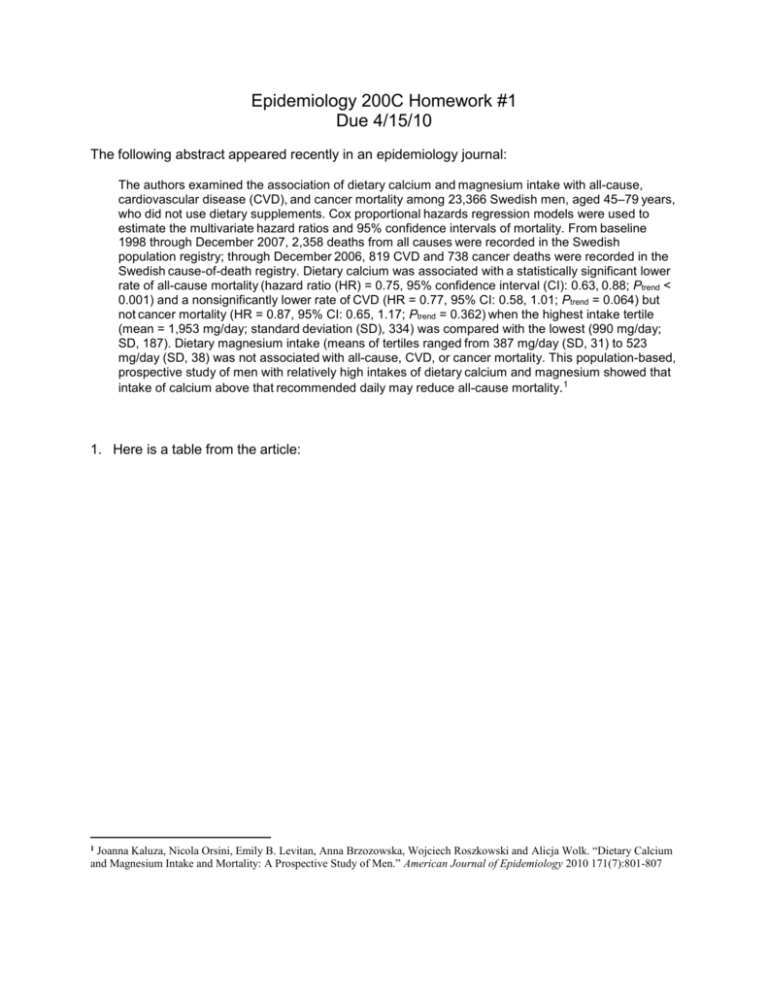Homework1
advertisement

Epidemiology 200C Homework #1 Due 4/15/10 The following abstract appeared recently in an epidemiology journal: The authors examined the association of dietary calcium and magnesium intake with all-cause, cardiovascular disease (CVD), and cancer mortality among 23,366 Swedish men, aged 45–79 years, who did not use dietary supplements. Cox proportional hazards regression models were used to estimate the multivariate hazard ratios and 95% confidence intervals of mortality. From baseline 1998 through December 2007, 2,358 deaths from all causes were recorded in the Swedish population registry; through December 2006, 819 CVD and 738 cancer deaths were recorded in the Swedish cause-of-death registry. Dietary calcium was associated with a statistically significant lower rate of all-cause mortality (hazard ratio (HR) = 0.75, 95% confidence interval (CI): 0.63, 0.88; Ptrend < 0.001) and a nonsignificantly lower rate of CVD (HR = 0.77, 95% CI: 0.58, 1.01; Ptrend = 0.064) but not cancer mortality (HR = 0.87, 95% CI: 0.65, 1.17; Ptrend = 0.362) when the highest intake tertile (mean = 1,953 mg/day; standard deviation (SD), 334) was compared with the lowest (990 mg/day; SD, 187). Dietary magnesium intake (means of tertiles ranged from 387 mg/day (SD, 31) to 523 mg/day (SD, 38) was not associated with all-cause, CVD, or cancer mortality. This population-based, prospective study of men with relatively high intakes of dietary calcium and magnesium showed that intake of calcium above that recommended daily may reduce all-cause mortality.1 1. Here is a table from the article: Joanna Kaluza, Nicola Orsini, Emily B. Levitan, Anna Brzozowska, Wojciech Roszkowski and Alicja Wolk. “Dietary Calcium and Magnesium Intake and Mortality: A Prospective Study of Men.” American Journal of Epidemiology 2010 171(7):801-807 1 a) Assuming there is no measurement error or selection bias, and all confounding is controlled by the multivariate analysis, do the results presented here provide evidence that there is no causal effect of magnesium intake on any of the mortality outcomes? Explain. You can treat the hazard ratios as if they were rate ratios. b) Look at the multivariate adjusted confidence interval for the hazard ratio for calcium intake greater than 1,599 mg/day and CVD mortality. Is the null hypothesis the hypothesis most compatible with the data under the model? Do the data seem highly compatible with a lack of effect, assuming no bias? 2. If you had not seen the abstract or the table, would a flat prior (one that assigns an equal probability to any value of the hazard ratio) for the measure of the causal effect of calcium or magnesium intake on any of the mortality outcomes seem reasonable? 3. Looking at the age-adjusted 95% CI for Calcium Intake of > 1599, would you conclude that there is a 95% probability that the true parameter value of interest lies within the interval of [0.84-1.02]? Explain. 4. The authors concluded that calcium intake was significantly associated with all-cause mortality. What could have made the P-value calculated from their data (; Ptrend < 0.001) small enough to be considered “significant”? 5. Compare the multivariate adjusted point estimates and confidence intervals for the hazard ratio for calcium intake greater than 1,599 mg/day for all-cause mortality and CVD mortality. Would you have concluded that calcium intake was associated with all-cause mortality and not with CVD mortality? Is the effect size truly different? Explain.





